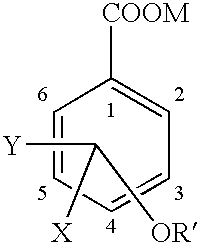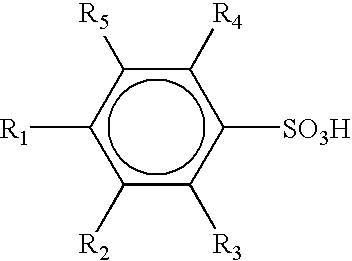Process for making bleach particles
a technology of bleach and granules, which is applied in the direction of detergent compounding agents, other chemical processes, fire extinguishers, etc., can solve the problems of self-accelerating thermal decomposition, and removing coloured stains from dishware/tableware, etc., to achieve the effect of improving stability and flowability, and not affecting the thermal stability of bleach
- Summary
- Abstract
- Description
- Claims
- Application Information
AI Technical Summary
Benefits of technology
Problems solved by technology
Method used
Image
Examples
examples
[0078]
TABLE 1A (% wt)B (% wt)C (% wt)D (% wt)Dilauryl peroxide98.25797979BHT0.75111Sodium sulphate10Sodium citrate101010Citric acid1010Silica1
[0079]Granules having the compositions showed in table 1 where made using a Pharmapaktor L 200 / 50P roller compactor (available from Hosokawa Bepex GmbH). The rolls had a concave / cylindrical profile (WP 12 profile) and a working width of 5 cm.
[0080]BHT, sodium sulphate, sodium citrate and citric acid were separately ground to a mean particle size, by weight thereof, of less than about 250 μm. BHT was ground in a rotor stator mill in presence of liquid nitrogen to control the rise of temperature during the milling. The pre-ground material was mixed with the dilauryl peroxide in a tumbling drum mixer to produce compositions A to D.
[0081]Composition A was feed into the roller compactor through a screw feeder at a speed of about 100 min−1, the mixture was compacted, using a press force of about 9 KN and a roll speed of about 10 min−1 to produce fla...
PUM
| Property | Measurement | Unit |
|---|---|---|
| temperature | aaaaa | aaaaa |
| pressure | aaaaa | aaaaa |
| density | aaaaa | aaaaa |
Abstract
Description
Claims
Application Information
 Login to View More
Login to View More - R&D
- Intellectual Property
- Life Sciences
- Materials
- Tech Scout
- Unparalleled Data Quality
- Higher Quality Content
- 60% Fewer Hallucinations
Browse by: Latest US Patents, China's latest patents, Technical Efficacy Thesaurus, Application Domain, Technology Topic, Popular Technical Reports.
© 2025 PatSnap. All rights reserved.Legal|Privacy policy|Modern Slavery Act Transparency Statement|Sitemap|About US| Contact US: help@patsnap.com



